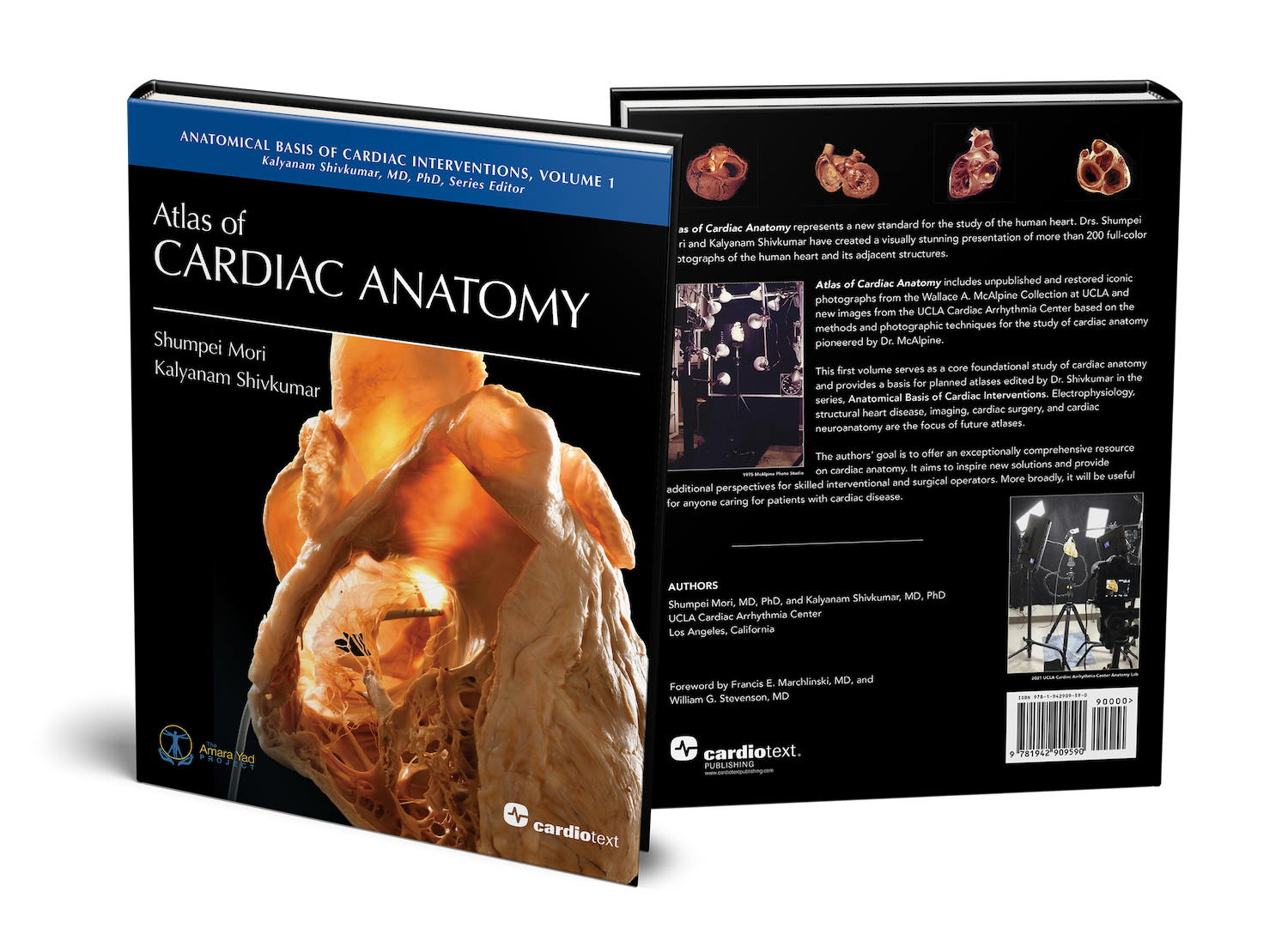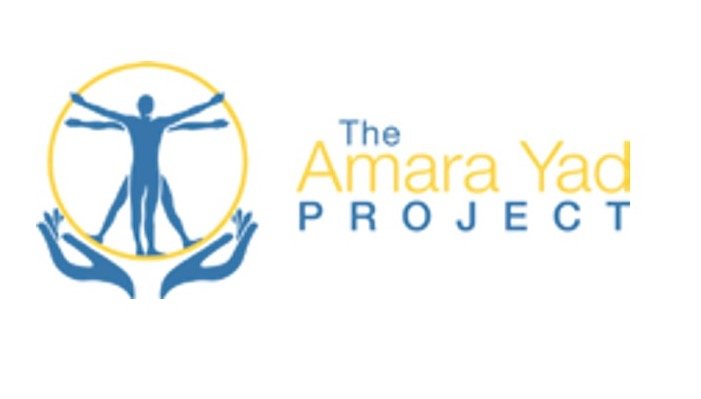Atlas of Cardiac Anatomy
Atlas of Cardiac Anatomy
Atlas of Cardiac Anatomy
by Shumpei Mori, MD, PhD and Kalyanam Shivkumar, MD, PhD
Publication Details
Publication Date: September 2022
ISBN: 9781942909576
Trim Size: 8.5 x 11 inches
392 pages
Format: Hardcover
A digital edition of this title is available gratis under Creative Commons license Attribution-NonCommercial-NoDerivatives 4.0 International.
This gratis edition does not include a set of 25 anaglyphs (stereoscopic images), but you may purchase them here.
You may also be interested in this title (May 2024):
Atlas of Interventional Electrophysiology
Roderick Tung, MD; Shumpei Mori, MD, PhD; Kalyanam Shivkumar, MD, PhD
About:
A comprehensive resource of cardiac anatomy and the surrounding structures.
This Atlas of Cardiac Anatomy represents a new standard for the study of the human heart. Drs. Shumpei Mori and Kalyanam Shivkumar have created a visually stunning presentation of more than 200 full-color photographs of the human heart and its adjacent structures.
Atlas of Cardiac Anatomy includes unpublished and restored iconic photographs from the Wallace A. McAlpine Collection at UCLA and new images from the UCLA Cardiac Arrhythmia Center based on the methods and photographic techniques for the study of cardiac anatomy pioneered by Dr. McAlpine.
This first volume serves as a core foundational study of cardiac anatomy and provides a basis for planned atlases edited by Dr. Shivkumar in the series, Anatomical Basis of Cardiac Interventions. Electrophysiology, structural heart disease, imaging, cardiac surgery, and cardiac neuroanatomy are the focus of future atlases.
A component of the print edition is a set of 25 anaglyphs (stereoscopic images) available online that correspond with specific photographs marked with the icon in the caption. Anaglyphs provide a 3D effect when viewed with 3D glasses (a red lens and a cyan lens). This publication does not include 3D glasses, but a variety of 3D glasses are available at various online retailers.
The authors’ goals are to offer an exceptionally comprehensive resource on cardiac anatomy. It aims to inspire new solutions and provide additional perspectives for skilled interventional and surgical operators. More broadly, it is likely to be useful for anyone caring for patients with cardiac disease.
Authors:
Shumpei Mori, MD, PhD
Associate Professor and Director, Specialized Program for Anatomy & Imaging
UCLA Cardiac Arrhythmia Center
Los Angeles, California
Dr. Mori is a physician scientist who is serving as the Director of the Specialized Program for Anatomy & Imaging at UCLA Cardiac Arrythmia Center. His field of specialization is cardiac anatomy and advanced clinical imaging. He has a long track record of publications and has published several books. He currently serves as an editor of Clinical Anatomy and Section Editor at the Journal of the American College of Cardiology: Clinical Electrophysiology.
Kalyanam Shivkumar, MD, PhD
Professor of Medicine (Cardiology), Radiology & Bioengineering
Director, UCLA Cardiac Arrhythmia Center & EP Programs
Director & Chief, UCLA Cardiovascular & Interventional Programs
Los Angeles, California
Dr. Shivkumar is a physician scientist serving as the inaugural director of the UCLA Cardiac Arrhythmia Center & EP Programs (since its establishment in 2002) and as the Director and Chief of UCLA’s Cardiovascular and Interventional Programs. He leads a team that provides state-of-the-art clinical care and has developed several innovative therapies for the non-pharmacological management of cardiac arrhythmias and other cardiac diseases. He has a long track record of research publications and books. He has been elected as a member of the American Society of Clinical Investigation (ASCI), the Association of American Physicians (AAP), the Association of University Cardiologists (AUC), and is as an honorary fellow of the Royal College of Physicians, London (FRCP). He currently serves as the Editor-in-Chief of the Journal of the American College of Cardiology: Clinical Electrophysiology.
Foreword by Francis E. Marchlinski, MD, and William G. Stevenson, MD
Atlas of Cardiac Anatomy is the inaugural volume of the Amara Yad Project.
Amara Yad (The Immortal Hand) is a physician-led initiative with a single goal: To honor the victims of medical exploitation through corrective action. As its first act, Amara Yad will publish a new generation of open-access digital anatomic atlases of the highest quality. These digital atlases will be made available gratis to all users to support the life-saving mission of the profession, made possible with the generous backing of the Amara Yad Project initiated by the UCLA Cardiac Arrhythmia Center in 2022.
THE HISTORY
Between 1938 and the end of World War II, University of Vienna anatomist Eduard Pernkopf published a series of anatomical atlases. He used the bodies of over 1,300 murdered victims of Nazi terror as subjects for his work. The Nazi history of the Pernkopf atlas series was concealed in the 1950s. Swastikas and SS insignia proudly displayed in the illustrators’ signatures of those atlases were erased (partially) from prints in subsequent editions of the atlas. For decades, physicians used Pernkopf ’s atlases without the knowledge that bodies depicted in those works belonged to the victims of Nazi atrocities. The atlases were regarded as preeminent anatomical resources, a clinical necessity, and remained in use even after their depraved origins had been exposed. Importantly, no effort was made to surpass this work and provide a definitive resource for the world.
TODAY
Anatomic atlases are an indispensable resource for medical professionals. At UCLA, the production of clear and accurate atlases that support the lifesaving mission of the profession is made possible by the University’s Willed Body Donor Program, U.S. federal research support for science, financial gifts from donors, and volunteer efforts of students and faculty.
We dedicate this inaugural volume of the Amara Yad Project to the noble humans who have so generously willed their bodies for science and education. We also specifically honor the victims of medical exploitation in Pernkopf ’s atlases. We shift the focus away from the images of their bodies and toward their enduring human dignity.



